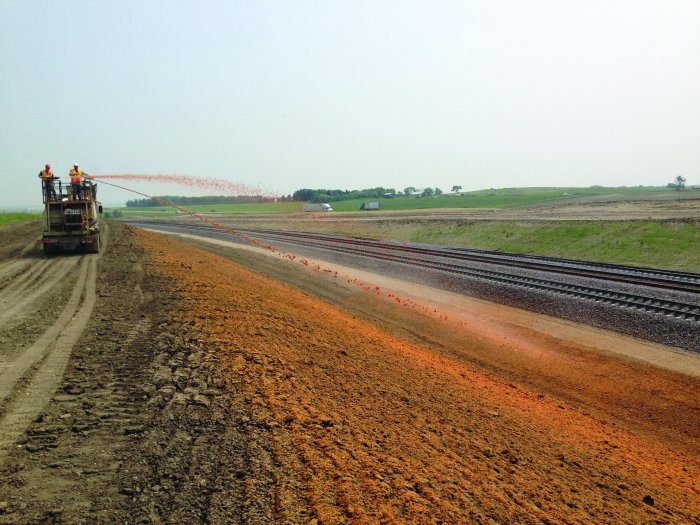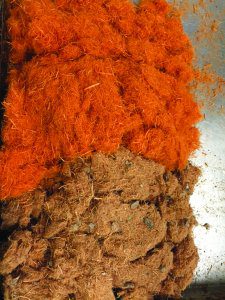Engineered Solutions: Steep Railway Corridors

North Dakota’s Bakken oilfields experienced a boom in production in 2013. With oil prices soaring, production of crude was reaching 2 million barrels per day. Pipeline infrastructure was not in place at that time, requiring 95 percent of the oil to be shipped via rail. The single rail line into the region was quickly overtaxed, prompting The Burlington Northern Santa Fe (BNSF) railroad to begin construction on a second rail line.
As the track project got underway, considerations for erosion control and site revegetation were subcontracted to Sherbrooke Turf, and the project specifications called for double-net erosion control blankets. Owner David Sherbrooke, however, knew that blankets would be far too time-consuming and labor-intensive to be economically feasible. With that in mind, Sherbrooke submitted a hydraulically applied Bonded Fiber Matrix (BFM) as an alternative to the specified blankets.
“With the size and scope of the project, blankets were simply never going to produce the results or efficiencies of using BFM,” notes Adam Popenhagen, market development manager for Profile Products.
Save Time, Money
Sherbrooke knew that the BFM would deliver better erosion control, provide enhanced growth performance, and save substantial time and money. BNSF agreed to the material change with one caveat: Any BFM used on the project had to meet BNSF’s signature orange color; a tough task for any manufacturing company. Profile immediately got to work on testing different colors that would be suitable for the task at hand.
The approved product also was required to meet the North Dakota Department of Transportation BFM specification of 90 percent wood fiber, 9 percent natural binder and 1 percent organic and mineral activators—a specification met by Profile’s Hydro-Blanket BFM. What began as a daunting task for blankets became a much faster and easier project with the use of hydraulic erosion control products.
Second-Phase Upgrades
Profile, along with distribution partner Ramy Turf, became deeply involved in the 100-mile project. Sherbrooke was brought in for consultation and fine-tuning of the Hydro-Blanket’s orange color.

Tight timelines and difficult terrain were just two of the challenges facing Sherbrooke’s crews. Work stoppages to allow trains to pass, close scrutiny from the general contractor and monthly visits from BNSF’s most-famous investor, Warren Buffett, kept crews on their toes.
To manage the high volume of work, which at times saw crews applying up to 25 tons of Hydro-Blanket BFM daily, Sherbrooke developed a tablet-based tracking system to manage application crews, loading of the Hydro-Blanket and travel times of the three 3,000-gallon hydroseeders.
“Management of this project was a gigantic undertaking in its own right,” states Popenhagen. “Ramy Turf did a fantastic job of continual inventory for Sherbrooke and his crew in some very remote areas of North Dakota.”
Shipping challenges and Sherbrooke’s volume of daily product needs kept Ramy Turf monitoring the project seven days a week. Many site visits were required by the Profile/Ramy Turf team to work with the crew and keep the project running smoothly.
Hydro-Blanket Bonded Fiber Matrix
Tests prove Hydro-Blanket controls erosion more completely than competitive BFMs on steep 1:1 sites subject to heavy rains. The following are key product traits that proved useful at the site:
• Fast, effective hydraulic application on the steepest sites.
• Provides a better yield and more cost-efficient coverage than other BFMs.
• Less-expensive and faster to install when compared with blankets or sod.
• Combines Thermally Refined wood fibers and a multi-dimensional tackifier to achieve greater water-holding capacity and promote
more-complete germination and faster vegetation establishment.
• Uses a cross-linked hydro-colloid tackifier, super-absorbent co-polymer gel and polyacrylamide to securely anchor the fiber mulch matrix
to the soil surface.
• Dries to form a breathable blanket that’s environmentally safe and fully biodegradable.
Typical Application Rates
< 3:1 slope – 3,000 pounds/acre
2:1 slope – 3,500 pounds/acre
1:1 slope – 4,000 pounds/acre
In the end, the hard work and meticulous planning paid off. Thanks to the selection of Hydro-Blanket Bonded Fiber Matrix over traditional blankets, the project exceeded requirements of no erosion and 70 percent revegetative cover. This successful revegetation effort, coupled with the need to meet custom requirements from the client, earned this project recognition as one of Profile Products’ 2015 Projects of the Year.
About Adam Dibble
Adam Dibble, CESSWI, is the senior marketing and erosion control brand manager for Profile Products LLC; email: [email protected].


